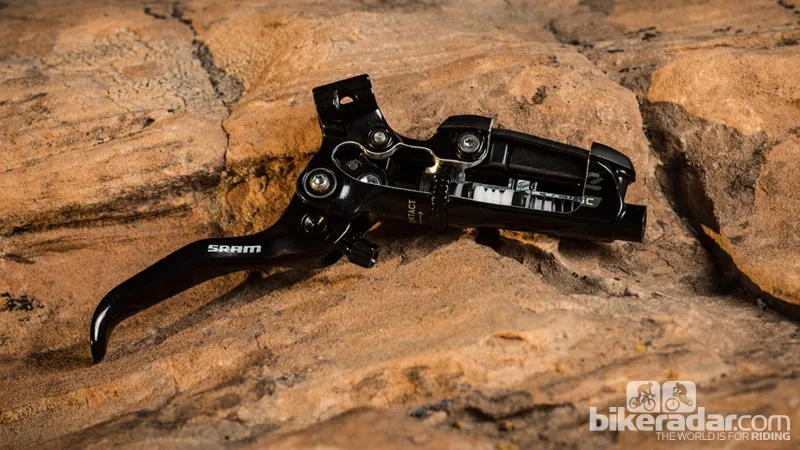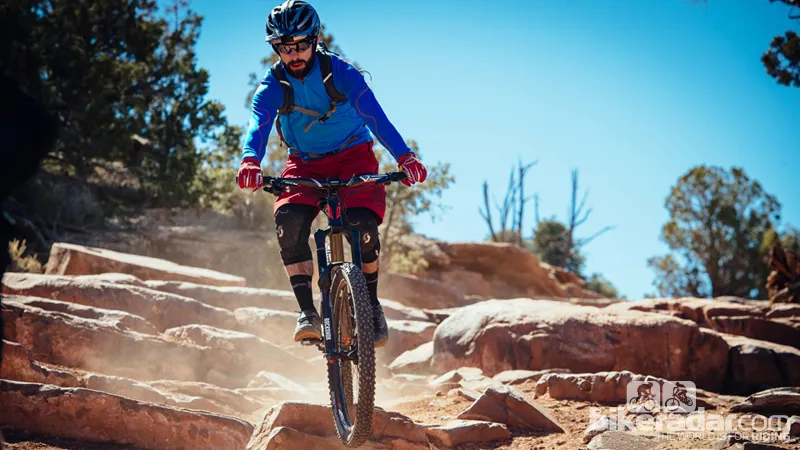The Guide is SRAM’s new trail brake, and is aimed at "everything from hardtails to full-on enduro rigs", according to SRAM’s James Alberts.
Although SRAM will continue to offer dedicated cross-country and downhill brakes, the company seems to understand just how popular and important everyday trail riding and enduro racing have become, and now offers a dedicated brake for the category.
The keen-eyed among you will have noticed that the new Guide brake comes under the SRAM banner and not Avid, as many would have expected. We know what you’re going to say: they already have the Trail brake, right? Well, the Guide is actually here to replace the Avid Elixir 7 Trail, Elixir 9 Trail and X0 Trail brakes completely.
Just like the Trail line it replaces, the Guide will be available in three different models: the RSC, the RS and the R.
Inside the SRAM Guide lever
Even a quick glance reveals that the Guide lever is dramatically different to SRAM's Trail offering. The Chicago-based company opted for a piggyback reservoir configuration, which helps increase overall fluid volume. In fact, SRAM claims the Guide’s fluid volume is actually three times more than that of the X0 Trail brakes. But what does this mean for us, the end ‘brakers’? More fluid volume gives the engineers more of a buffer or, more of a ‘margin of error’ to keep the brakes working consistently when faced with variables that could ultimately affect stopping performance.
“Negative volume allows room for expansion. When your brake gets hot, fluid can creep in each direction, so negative volume can take up that room,” Alberts said. It also help deal with any moisture getting into the system too.
“Positive volume helps you with having more air in the system. It gives you more margin for error for those riders servicing the brakes themselves," he said. "Even with quite a bit of air in the system, the brake will function just fine."
The small perch in the cutaway lever (which has two ports inside) helps prevent air from getting back into the system, further bolstering this margin of error and keeping a consistency in feel with little maintenance.
The bladder inside the lever was overhauled with a more compliant butyl material that works better with DOT fluid than the previous material and reduces the chance of creating a vacuum in the system. Now dubbed the ‘Pure Bladder,’ this new system reduces the migration of air and moisture, keeping it out of the system and keeping braking more consistent.
To further improve lever feel and consistency, SRAM's new TPC (Timing Port Closure) Plus system is the connection between the reservoir and the master cylinder bore, which consists of "cup seals in a bore that pressurise the system by passing by those timing ports [in the perch],” Alberts said. A smooth bore finish reduces cup seal wear, Alberts said, creating a brake that works consistently.
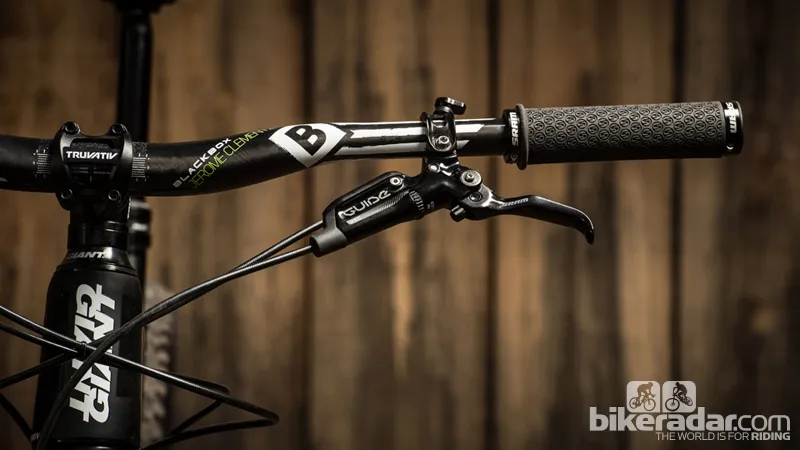
SRAM’s new Guide RSC brake lever features tool-free reach adjust, contact point adjustment and SwingLink technology
When you pull the lever, you can feel a subtle change over the previous Trail brake. This is, in part at least, thanks to the new Swinglink system, a cam configuration that pivots on a Teflon-coated bearing. SRAM created the Swinglink to reduce ‘deadband’ — the amount of travel your lever has before the pads engage with the rotor — and makes the pad engagement with the rotor more distinct and positive.
The Swinglink cam mechanism also allowed SRAM to tailor the lever travel versus the leverage ratio, as well as the feel. This means that although the force required at the lever at the beginning of the stroke is higher than the X0 Trail brake, the pads can move to the rotor more quickly (with less deadband), and as you continue to pull the lever, the leverage rate does eventually match that of the X0 Trail, giving the power and modulation that the soon-to-be-retired brakes have always been praised for.
It’s worth noting that of the three models available, only the top RSC model will get tool-free reach adjustment (now moved to the outside edge of the lever to improve compatibility with Gripshift), Swinglink technology and improved contact-point adjustment. The RS model receives tool-free reach adjustment and Swinglink technology, while the entry level R model only gets the tool-free reach adjust.
The SRAM Guide calliper, rotor and pads
The Guide calliper is basically the same as used on the X0 Trail brake. Impressively, SRAM claim this four-piston calliper is just 4g heavier than a two-piston calliper. The four pistons use two different diameters, 16mm and 14mm (the smaller of which is the leading piston during rotation). This configuration has allowed the engineers to help dictate how the power is applied.
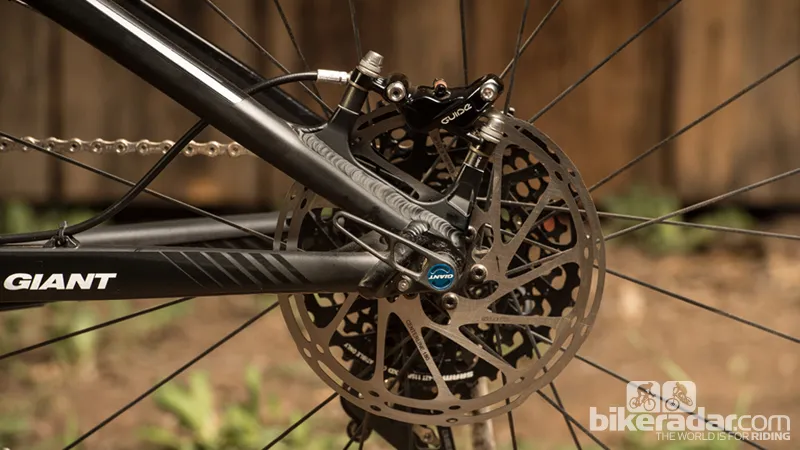
The Guide calliper is essentially the same four piston calliper as used on their soon to be retired X0 Trail brakes
The all-new Centerline rotor does look very different to much of what we’ve seen from SRAM over the past few years. The name has come about thanks to the cut outs used around the centre of the rotor. These “help to keep the centroid of friction consistent,” according to Alberts. With this non-wavey design, keeping the "centroid of friction consistent" means vibration is reduced, keeping things smoother and quieter under heavy braking.
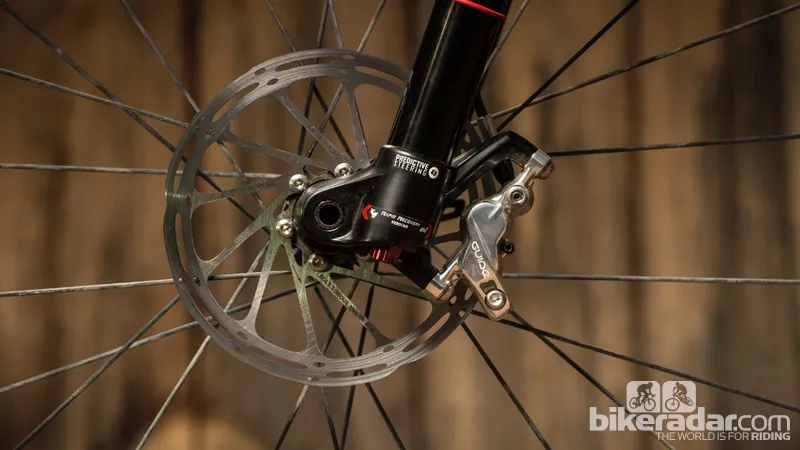
No more wavy style rotors here. The Guide’s new Centreline rotor helps to reduce noise and heat build-up in the system
The design of the 1.85mm rotor allows it to expand and contract in the same plane which helps to avoid warping.
The Centerline rotor will be available in 140, 160, 170, 180 and 200mm sizes. The Centreline rotor is 5g heavier than the current HS1 rotor (comparing 180mm rotors).
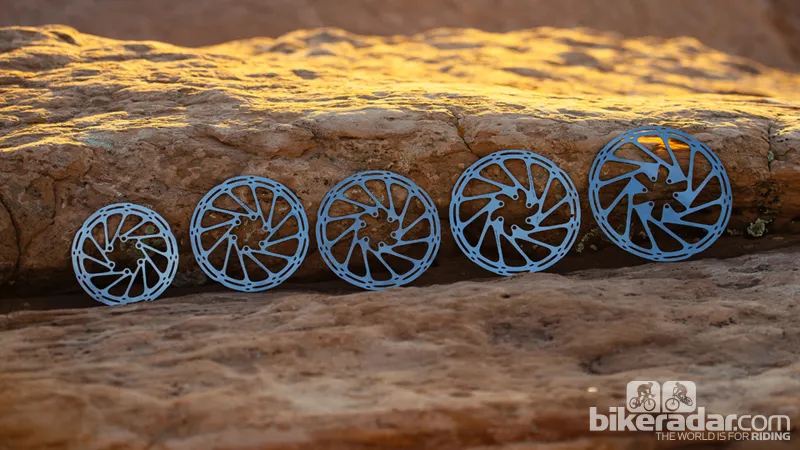
The Centreline rotor will come in five different sizes
SRAM worked on its organic pads, looking into pad material, backing plate construction and manufacturing techniques. The result is a new organic pad material that, when paired with a flat, more consistent backing plate, really helps with noise issues. These will be available later in the year.
New models – available June 2014
SRAM Guide RSC
- Weight: 375g
- Features: Tool-free reach adjust, contact-point adjust, Swinglink, Pure Bladder, TPC Plus
- Lever: Alloy with ‘Bendzone’, pivot bearings
- Clamp: MatchMaker X compatible
- Calliper: Guide
- Colours: Polished Silver Ano or Black Ano
- Price: US$199 / €177 / UK pricing TBC
SRAM Guide RS
- Weight: 380g
- Features: Tool-free reach adjust, Swinglink, Pure Bladder, TPC Plus
- Lever: Alloy with ‘Bendzone’, pivot bushing
- Clamp: MatchMaker X compatible
- Calliper: Guide
- Colour: Black
- Price: US$149 / €132 / UK pricing TBC
SRAM Guide R
- Weight: 375g
- Features: Tool-free reach adjust, Directlink, Pure Bladder, TPC Plus
- Lever: Alloy with ‘Bendzone’, pivot bushing
- Clamp: MatchMaker X compatible
- Calliper: Guide
- Colour: Black
- Price: US$129 / €115 / UK pricing TBC
SRAM mountain bike brake product manager james alberts describes the new guide brake line
SRAM mountain bike brake product manager, James Alberts describes the new Guide brake line
